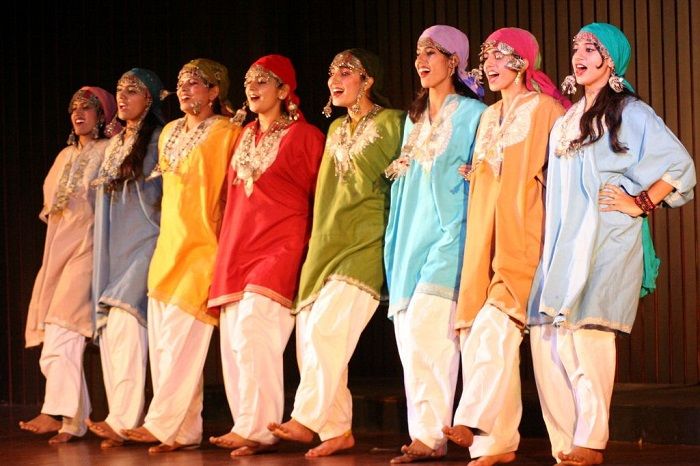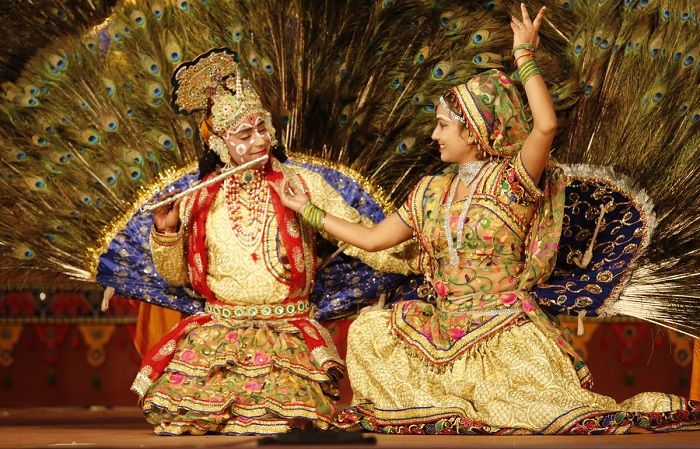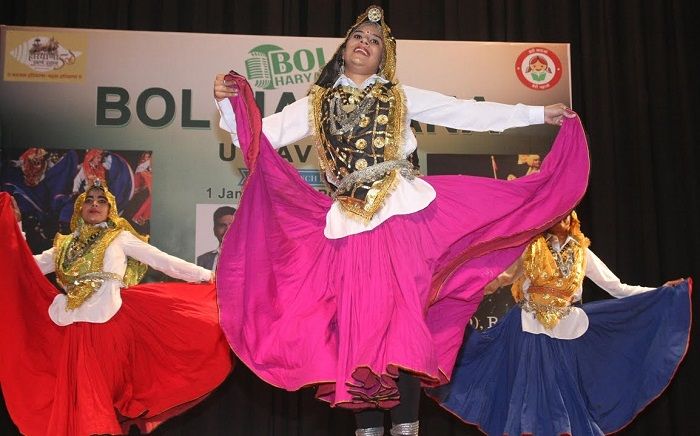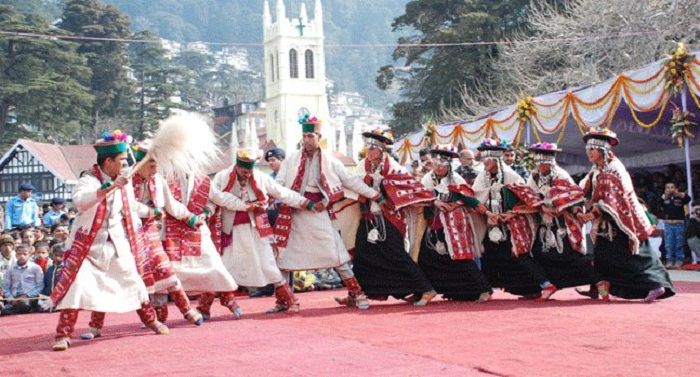Much like the culture and other elements that differ from place to place in North India, its folk dances too are well diversified in according to regional variations. While some dances involve acts of balancing, some are simple and focus more on conveying certain stories. No matter how simple or complicated the dance form is, it sure does hold cultural significance. Let’s take a look at folk dances of north India.
Kud Dance
Region/Area: Jammu & Kashmir
Occasion: Part of a thanksgiving ritual
Highlight: Both young and the old participate
Performed by both young and the old with equal enthusiasm, Kud is the main attraction in one of the thanksgiving rituals of the region. Farmers from different villages join hands and perform to thank the local deities. Instruments like Drums, ‘Narsingha’ – a conch-like instrument, and flutes are used. Kud is usually performed during night in rainy season and involves 20 to 30 dancers.
Rouf Dance
Region/Area: Jammu & Kashmir
Occasion: Performed during festivals
Highlight: The dance is performed by women wearing colorful clothes
Rouf dance is performed during festivals like Eid al-Fitr and Ramzan. Women dancers form two separate rows, with women of one row facing their counterparts from the other row. They then place their arms around the waist of the dancers standing next to them and start dancing gracefully to the rhythm of a mystical poetry that supports the dance. Rouf is usually performed in spring and is also associated with harvesting.

Bhand Pather
Region/Area: Kashmir
Occasion: Performed to entertain the masses
Highlight: Use of items like whip and a short stick make the act dramatic
Bhand Pather is a theatre art form which conveys mythological stories by incorporating contemporary social issues in a satirical manner. Folk songs are sung to support the act and are accompanied by instruments like ‘Swarnai’, ‘Thalij’, ‘Dhol’ and ‘Nagara’. While ‘Swarnai’ is a wind instrument which takes care of the tune, ‘Dhol’, ‘Nagara’ and ‘Thalij’ are percussion instruments. The act is often dramatized by the use of items like whip and a short bamboo stick.
Bachha Nagma
Region/Area: Kashmir
Occasion: Performed in weddings and other social gatherings
Highlight: Men and boys dress like women
Performed in weddings and other social gatherings in Kashmir, Bachha Nagma is usually performed by boys who don the traditional attire of women. The lead dancer begins to sing and others start dancing according to the tune of the dancer-cum-singer. Bachha Nagma holds a historical significance and considered important among the people of Kashmir.
Dumhal
Region/Area: Kashmir
Occasion: Performed in rituals
Highlight: Dancers wear clothes of vibrant colors which makes the dance that much more attractive
Dumhal is a popular dance form of Kashmir. This dance is performed by men belonging to the Wattal tribe who wear long and colorful clothes. They also wear tall conical hats decorated with beads and shells. Dumhal dance is accompanied by songs which the performers sing themselves and is supported by drums. The dance is performed around a banner which is carried and placed into the ground by the dancers prior to the commencement of the dance.
Rasa Lila Dance
Region/Area: Uttar Pradesh/ Haryana
Occasion: Performed during festivals
Highlight: Depicts love stories of Lord Krishna
Rasa Lila is considered sacred by the devotees of Krishna as it is believed that this dance form was performed by Krishna himself. The dance is usually performed during night and goes on till daybreak. Performed either by boys or girls (only by girls in certain places), Rasa Lila conveys loves stories of Krishna. The dance is usually accompanied by folk or devotional song.

Loor
Region/Area: Haryana
Occasion: Performed to mark the beginning of spring
Highlight: The songs are basically questions and answers
Loor is an attractive dance form which is performed only by girls belonging to the Bangar area of Haryana. It is performed during the Holi festival and is seen as a ritual to welcome the season of spring. The dance form is significant to the farmers as it is performed before sowing of the Rabi crops. Songs used to support the dance are basically questions and answers.
Gogga Dance
Region/Area: Haryana
Occasion: Performed during a ritual
Highlight: Devotees dance around the grave of a saint
Performed only by men, Gogga (also spelled as Gugga) dance is a form of worship. Devotees of Saint Gogga dance around his grave and sing his praises. Dance movements are kept simple as the devotees focus more on gaining spiritual experiences.

Dhamyal
Region/Area: Haryana
Occasion: To mark the end of a day’s work
Highlight: The drum played during the performance makes a unique sound
‘Dhamyal’ or ‘Dhuph’ is a popular folk dance of Haryana. The dance is performed either by men alone or with women. A circular drum (Dhup) is played by the male dancers. The spring season is a time of celebration in Haryana and the dance contributes to the celebration. To mark the end of a day’s work, farmers and tribes dance to their heart’s content.
Nati
Region/Area: Himachal Pradesh
Occasion: Performed during festivals
Highlight: Nati is classified into seven different types with each dance form having its own style
Nati is classified into seven different dance forms. Some of the most famous ones are – Kinnauri Nati, Kullu Nati and Shiv Badar Nati. While Kinnauri Nati is performed to welcome the New Year, Kullu Nati is performed during Dusshera. Kullu Nati is performed for long hours until the dancers are completely drained out. Shiv Badar Nati is performed during Maha Shivaratri and conveys the legend of Lord Shiva.

Dangi
Region/Area: Himachal Pradesh
Occasion: Performed during harvest season
Highlight: The dance involves various themes
Dangi is arguably the oldest folk dance of Himachal Pradesh. Performed in temples to welcome the season of harvest, Dangi involves women dancers. Different themes are used by the dancers, which subsequently convey different stories. One such story involves a love relationship between a king and a commoner.
Mayur Nritya
Region/Area: Uttar Pradesh
Occasion: Worship and rituals
Highlight: Dancers disguise themselves as peacocks
Mayur Nritya is an interesting dance form as dancers wear special clothes in order to resemble peacocks. Legend has it that Lord Krishna once disguised himself as a peacock and performed the dance to impress Radha. The dance is performed by girls and involves graceful movements.
Hurka Baul
Region/Area: Uttarakhand
Occasion: Performed while cultivating crops
Highlight: Narration of stories
The Hurka Baul dance is performed during the cultivation of paddy and maize. The name of the dance is derived from Hurka, the drum which is the only musical accompaniment and baul, the song. In the Hurka Baul dance the singer narrates the story of battles and heroic deeds, while the performers enter from two opposite sides and enact the stories in a series of crisp movements.
Langvir Nritya
Region/Area: Uttarakhand
Occasion: Performed in festivals and for entertainment
Highlight: Dancing happens on a pole
This is a unique dance form in which the dancer ascends a long bamboo pole and balances himself on the tip of the pole. He also performs acrobatic moves while musicians play drums to support the performer. Popular in Tehri Garhwal region, Langvir Nritya is performed only by the men folk.
Bhangra
Region/Area: Punjab
Occasion: Performed during harvest season
Highlight: Difficult and unique dance steps
Performed by the men folk during Baisakhi, Bhangra is among the most energetic and captivating dances of India and includes tricks and athletic feats. During the Bhangra performance the drummer is surrounded by men dressed in lungis and turbans. The dresses worn by the dancers are usually bright in colors.
Giddha
Region/Area: Punjab
Occasion: Performed in a festival
Highlight: Expresses feminine grace
The dance performed by the women folk of Punjab is called Giddha. In the Giddha dance a woman or a pair of women dance while the others surrounding them clap in rhythm. It is performed during the festival of Teeyan to welcome the monsoons. Giddha is also known as the female version of Bhangra as it expresses feminine grace.



